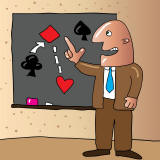How to Win at Poker
 The subject of this section is simple - we want to help you win at poker. No matter what game you play, we strive to provide you with high quality poker strategy that will help you crush your opponents. Click any of the links below to get started:
The subject of this section is simple - we want to help you win at poker. No matter what game you play, we strive to provide you with high quality poker strategy that will help you crush your opponents. Click any of the links below to get started:
List of Poker Strategy Guides:
We have organized our poker strategy section by game, so you can quickly find articles pertaining to your favorite game:
- Texas Hold'em Strategy
- Omaha Poker Strategy
- Seven Card Stud Strategy
- General Poker Strategy
Our site is still going through a full redesign, so expect to see more poker strategy soon. In the meantime, let's review a few strategies that apply to almost every poker game:
Tight-Aggressive Strategy
One poker strategy that applies to almost every poker game is a tight-aggressive approach. The tight-aggressive approach (known online as the TAG approach) has always been a winning poker strategy. Playing "tight-aggressive" means that you only play solid hands, but when you have a solid hand you play it aggressively.
Some approaches you want to avoid include the "Loose Aggressive" approach, where you play most hands and play them all aggressively, the "Loose Passive" approach, where you play many hands and play them all conservatively, and the "Tight Passive" approach, where you play only a few hands and play them conservatively.
Although certain situations may call for a quick switch to a different approach, the TAG poker strategy has been proven a winner over and over again.
Poker Bankroll Strategy
One of the most underrated aspects of a poker player's strategy is his/her bankroll strategy. Even if you are the best poker player in the world, you could easily go broke without proper bankroll management.
So how large should your bankroll be? Well, it depends on your skill, your goals, and your stakes. Let's look at each factor now:
- More skilled players can survive on less of a bankroll than less skilled players, because they are less likely to have a big downswing.
- Casual players need less of a bankroll than professional players, because casual players can afford to go bust while professional players rely on their poker income.
- High stakes players should have more of a bankroll than low stakes players, because low stakes players face softer competition and can reload much easier if necessary.
If you are looking for exact numbers for your bankroll strategy, check out the table below. It is far from perfect, but is a good estimate of how much money you should have to play each level of poker depending on your goals:
| Bankroll Chart: | $1/$2 | $2/4 | $5/$10 | $10/$20 |
|---|---|---|---|---|
| Casual Player | $4,000 | $8,000 | $20,000 | $40,000 |
| Serious Player | $8,000 | $16,000 | $40,000 | $80,000 |
| Professional Player | $20,000+ | $40,000+ | $100,000+ | $200,000+ |
If you play at stakes different than the ones listed above, use this rule: if you are a casual player, you should have 20 buy-ins. If you are a serious player, you should have 40 buy-ins. If you are a professional player, you should have at least 100 buy-ins.
Poker Strategy Tools
Once you decide to become a serious or professional Internet poker player, the best way to improve your play is to analyze your Internet poker statistics to find and correct flaws in your game. Some of the most popular poker strategy tools include PokerTracker and PokerOffice. The programs download your hand histories and automatically analyze them so you can find holes in your game, and decide how to fix them.
